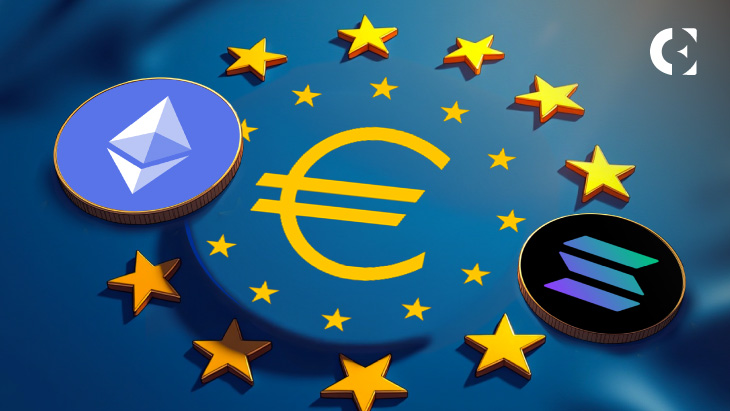- The decision is likely driven in part by increasing concern over the growing dominance of US dollar–pegged stablecoins
- Public blockchains offer many benefits because they are easy to use and can be adopted quickly, but they also have major privacy issues
- ECB has not yet made a definitive technical choice, as it remains open to a hybrid approach and is exploring both centralized and decentralized technologies
The Financial Times reports that the European Central Bank (ECB) is accelerating its Digital Euro planning and actively considering public blockchains like Ethereum and Solana (instead of a private, ECB-controlled ledger) as possible platforms for issuing the central bank digital currency (CBDC).
This decision is likely driven in part by increasing concern over the growing dominance of US dollar–pegged stablecoins, especially following the United States’ passing of the GENIUS Act, which has heightened the urgency to protect the euro’s global role.
It’s worth noting that even though public blockchains offer many benefits because they are easy to use and can be adopted quickly, they also have a big problem with privacy because everything on them is visible to everyone.
Related: Ethereum Runs the Game While Solana Struggles for Identity, Hayes Warns
In other words, choosing a public blockchain for the digital euro is a major change. Unlike China’s highly centralized CBDC or other traditional private systems, launching the digital euro on a platform like Ethereum or Solana could genuinely blur the distinction between government-issued money and public blockchain ecosystems.
As such, the ECB has not yet made a definitive technical choice. It remains open to a hybrid approach and is exploring both centralized and decentralized technologies, with final decisions still pending.
What this means for crypto
If the ECB goes through with its plan, it could position Ethereum and Solana as more than just crypto blockchains. They would turn into key platforms for government-backed money, in addition to likely boosting the innovation in real-world assets (RWAs) that are built on top of these platforms.
Additionally, in case the digital euro runs on public chains, it may inspire other countries to follow suit. Digital cash built atop crypto networks could become mainstream, breaking down ideological barriers between fintech innovation and central banking.
Related: Ethereum Is Now Wall Street’s Top Choice for AI and Tokenization Infrastructure
Plus, embedding central bank tokens on Ethereum or Solana opens the doors for seamless compatibility with DeFi protocols. This could enable new use cases, such as frictionless lending, more efficient cross-border transfers, and the creation of programmable money.
Earlier this year, it was reported that the ECB is also assessing blockchain-based infrastructure for wholesale settlements, with the goal of improving cross-border interoperability with established systems like TARGET (Trans-European Automated Real-time Gross Settlement Express Transfer).
Disclaimer: The information presented in this article is for informational and educational purposes only. The article does not constitute financial advice or advice of any kind. Coin Edition is not responsible for any losses incurred as a result of the utilization of content, products, or services mentioned. Readers are advised to exercise caution before taking any action related to the company.







